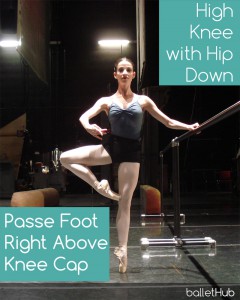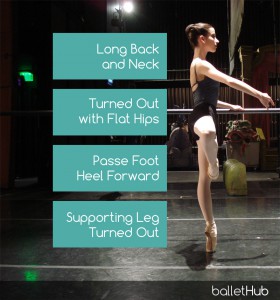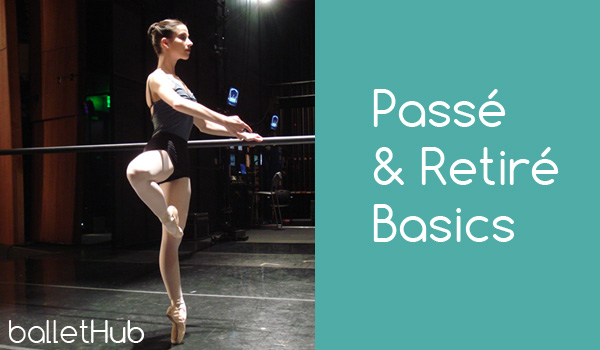Passe (pah-say) and Retiré (reh-tur-a) are often interchangeable ballet terms describing the same position where a dancer’s leg is bent upwards, with their toes typically connected to the other leg. Having the “passe leg” turned out is mostly common in classical ballet, but of course, passe (or retiré) can also exist as a turned in position in jazz, contemporary and other dance techniques.
Having a strong and proper passe is an important step in almost all forms of dance, but especially classical ballet. Just as many port de bras movements go through first position with the arms from one step to another, so do the legs often go through a passe position.
For example, a pirouette is most commonly done in passe. In an adagio combination, you will often go through passe from different develope positions. There are truely countless examples!
Let’s Take a Look at Passe in Classical Ballet
Here are what you want to look for in a proper passe:
 The “Height” of the Passe: Basically, how high the knee and foot is in relation to your hip. However, there is such a thing as too high, so the knee should never be above it’s corresponding hip. Another way to look at this is the angle of your quad muscle. If it is parallel with the ground, you’re in a good high passe. If it’s aiming mostly down towards the floor, you’ll want to raise it a bit!
The “Height” of the Passe: Basically, how high the knee and foot is in relation to your hip. However, there is such a thing as too high, so the knee should never be above it’s corresponding hip. Another way to look at this is the angle of your quad muscle. If it is parallel with the ground, you’re in a good high passe. If it’s aiming mostly down towards the floor, you’ll want to raise it a bit!- Hip Not Raised: It’s easy to achieve the goal above, but you must also do so without lifting your hip. Now of course, some hip movement may be necessary, but it should never be more than a couple inches or your hip will start to look hiked and out of position. If you can’t achieve a high position without lifting your hip, you can try some stretches to help loosen your hip joint. Also make sure that the passe does not engage from the hip… The top of your hip should actually be mostly relaxed! By relaxing the top of the hip joint, you’ve actually allowed it to move more freely and get to the position easier.
- Foot Right Above Knee: You will want to place your passe right above your knee cap and to the inside a little. Not the middle or heel of your foot so that your legs look like the number 4 with your toes sticking out the other side. Depending on the proportions of your leg, you may need to bring it slightly higher, but it should never be below your knee cap. As with all ballet technique, the foot should also not be sickled, but in a nice rotated position with the heel forward of the toes or in line. Having this same position but behind the knee would make it a “passe back” position.
 Engage the Correct Muscles: Like mentioned above, a proper passe position should not be held or started with your hip. Instead, think of holding and continually lifting into the position with both of your hamstrings, and the calf of your passe leg. These three muscles should actually form a nice triangle, and if you think of engaging and lifting these muscles, it will be much easier to hold and you won’t overuse your hip or other muscles. Your passe will also have a stronger look because your muscles are actively working as opposed to looking low energy and “sitting” into your leg.
Engage the Correct Muscles: Like mentioned above, a proper passe position should not be held or started with your hip. Instead, think of holding and continually lifting into the position with both of your hamstrings, and the calf of your passe leg. These three muscles should actually form a nice triangle, and if you think of engaging and lifting these muscles, it will be much easier to hold and you won’t overuse your hip or other muscles. Your passe will also have a stronger look because your muscles are actively working as opposed to looking low energy and “sitting” into your leg.- Proper Posture: Typically in classical ballet technique, while in a passe position the dancer has a usual balletic posture which includes a long neck and back. When the passe is turned out, the supporting or standing leg should also be turned out.
You may have noticed the points above were not numbered and that’s because they’re all equally as important! A nice high knee and low hip can look great but if your foot is below your knee and sickled, it may not look as good as you can possibly make it.
Aim for an Awesome Passe
Sometimes, passe can be mistaken for an “in between” step or position, or a secondary detail, when in fact it can be a very beautiful and powerful position. All too often, a dancer will worry more about the number of turns or how high their leg is raised to the side and not paying enough attention to the detail of the position they’re in. When someone talks about the quality of a pirouette, the position the dancer is turning in and the “height of the passe” is often brought up. Bottom line, having a finely tuned passe brings an overall more polished and technically impressive quality to a dancer.
Having a good passe that you’ve got in your back pocket doesn’t come over night. It often takes many years of daily classes for a dancer to truly achieve a position that is both technically proper but also beautiful and consistent enough to always do. Try one or two of the above points at first and see how you do. Once you feel comfortable, continue even further with those points while adding in others but still keeping the others in check!
Passe? Retiré? What’s the difference?
Mostly, nothing really. Passe translates in french as “to pass”. So the term is actually describing a movement where one foot is passing along side the opposite leg. Either way, it is commonly accepted to mean the same thing. For instance, doing a pirouette in passe or retiré should be the exact same position.

